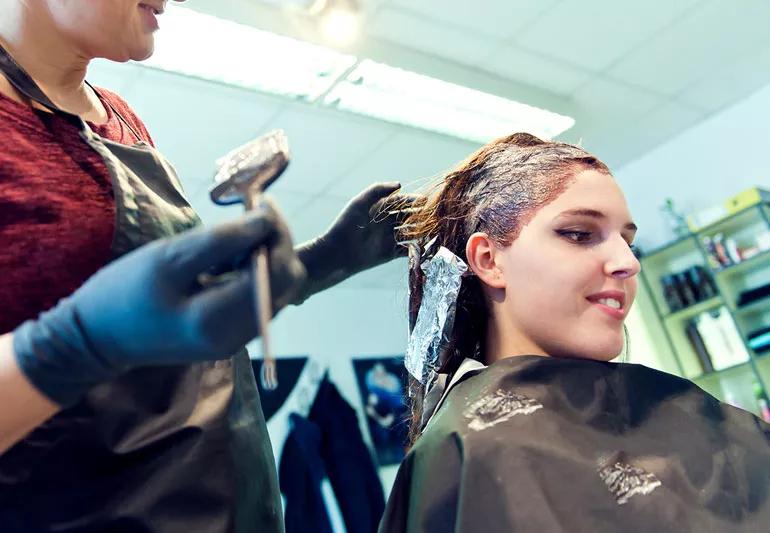Don’t let harsh chemicals damage skin or hair

If you’re among the millions of American women (and men) who dye their hair regularly, you may be exposing yourself to dangerous chemicals that damage hair and skin. The truth is, chemical-laden hair dyes can irritate your scalp and cause hair thinning or loss in some people — while the long-term health effects are not yet known.
Advertisement
Cleveland Clinic is a non-profit academic medical center. Advertising on our site helps support our mission. We do not endorse non-Cleveland Clinic products or services. Policy
Human skin, eyes and hair get their color naturally from melanin, a compound derived from the amino acid tyrosine. In a nutshell, the amount of melanin you have determines your hair, skin and eye color. When talking about natural hair color, for example, blondes have fewer melanin molecules than brunettes.
Hair dyes, on the other hand, use a veritable cocktail of chemicals to alter hair color. They often contain ammonia, lead acetates (Note: The FDA recently repealed approval of this ingredient, but it is pending), hydrogen peroxide and paraphenylenediamine (PPDA) – a common allergen.
“PPDA is common in both cheap and expensive hair dyes and present in nearly all permanent type dyes,” says dermatologist Melissa Piliang, MD. “Many people are allergic to it, so I recommend reading the ingredients on every hair dye product,” she says.
Although researchers have studied the long-term effects – including possible cancer risks – of hair dyes, many of the findings have been inconsistent or inconclusive. Essentially, this means that experts don’t have a clear understanding of the possible hazards of these dyes over time.
Permanent hair dyes use the harshest chemicals to alter hair color, but semi-permanent dyes (often used to cover graying hair) may still contain worrisome chemicals, including PPDA or a similar compound. That’s why it’s important to always read the ingredients on any type of hair color before using it, Dr. Piliang says.
Advertisement
Whenever you color your hair, watch out for signs of problems after use. “Any scalp redness, irritation, itching, scaling, flaking or blisters should raise concern,” Dr. Piliang says. If your symptoms are severe or last more than two days, she recommends making an appointment with a dermatologist or your primary care physician.
Other, less medically significant issues can occur from using hair dyes as well. They often tint the skin of the scalp for a few days, which may cause embarrassment. “Products that bleach or lighten hair color strip away the protective coating of the hair fibers. This makes the hair shaft thinner and weaker, which makes them more susceptible to damage,” Dr. Piliang explains. Using these bleaching and lightening formulations too often can make hair appear limp and lifeless and may even cause hair loss.
When dying your hair using a boxed product, follow these tips for best results:
The safest bet is to closely follow all instructions that come with your boxed hair dye and avoid formulations containing PPDA if you’re allergic.
If you want to avoid exposure to the chemicals contained in most artificial hair dyes, consider trying a natural substitute like a plant-based henna dye or another all-natural hair color product.
Looking to the future, there is potential for new and safer hair dyes. Researchers at North Carolina University have created a database with more than 300 substances in hair dye to research ways to make hair color safer and more sustainable.
Advertisement
Learn more about our editorial process.
Advertisement

Scalp cancers can occur because of long-term sun exposure

Soften your skin with warm water and shaving cream before shaving with the grain of the hair

Age is the most likely reason for typical graying, but premature graying may be caused by stress, diet, smoking or autoimmune disease

Focus on nutrition, gentle styling habits and adapting to your hair type

Eating whole grains, salmon, fruits and vegetables can help you achieve longer, healthier locks

Your genes, ethnicity, diet and stress levels may all affect your facial hair

Your hair removal routine will depend on your pain tolerance, budget and skin sensitivities

Prepping the area, exfoliating beforehand and communicating with your esthetician will help give you the best (and least painful) results

Babies can get congested easily, but you can calm their cough by keeping them hydrated, using nasal drops and running a humidifier

Weight loss may cause loose, sagging skin and muscle loss to your rear

Several conditions, like vitiligo and fungal infection, can cause a loss of pigmentation, leading to white spots or patches on your skin